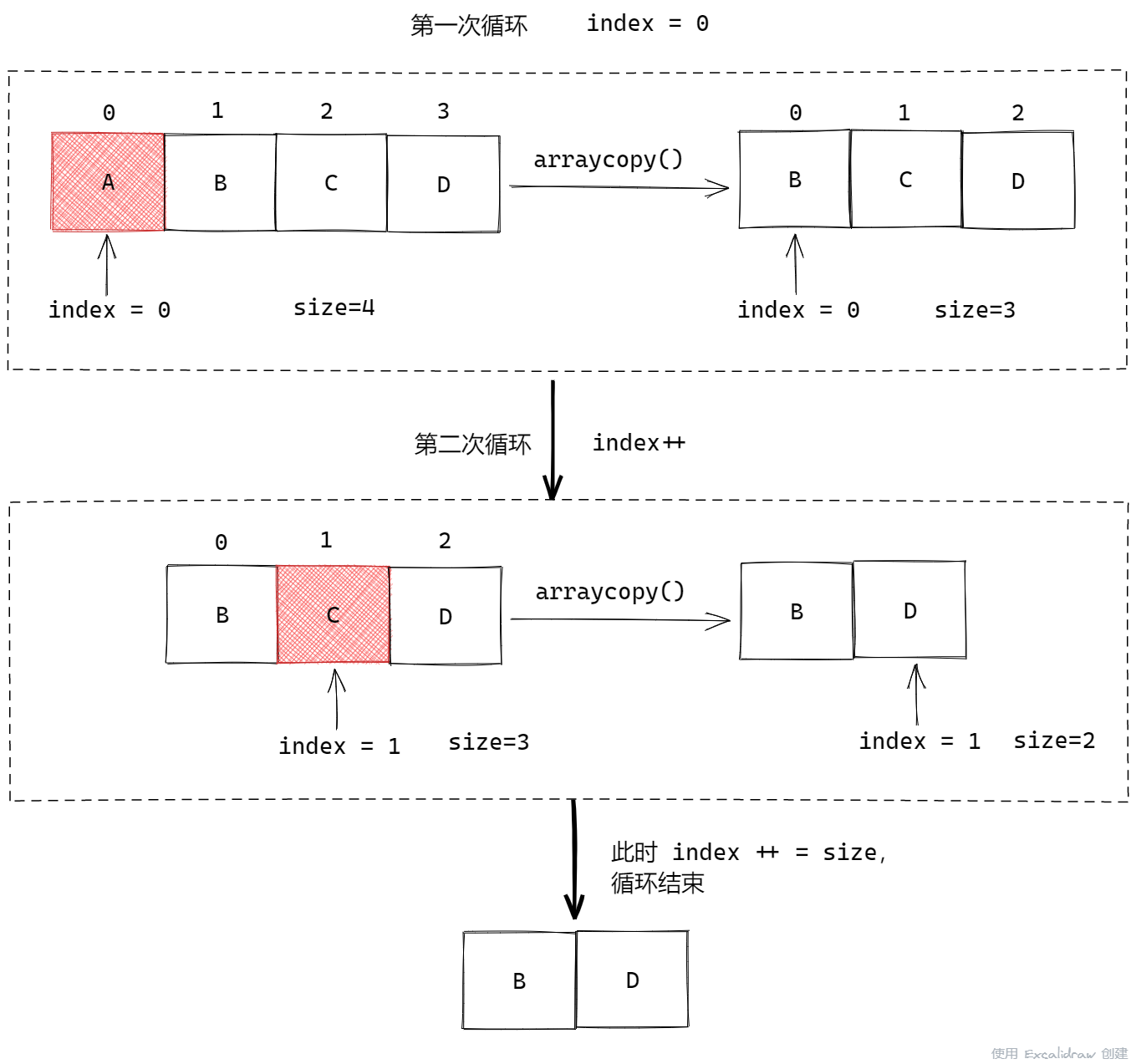ArrayList与LinkedList遍历操作问题
作者:互联网
概述
一个 java 程序猿比较广为人知的小知识 ,是 ArrayList 和 LinkedList 最好使用迭代器删除,而不是遍历删除。
当我们尝试使用 for 循环或者 forEach 进行删除的时候,往往会出现一些意外的情况,导致集合全部删除失败。关于这点,我一直保持知其然不知其所以然的状态,刚好最近刚看完 ArrayList 和 LinkedList 的源码,今天这篇文章,就结合源码,总结一下 ArrayList 和 LinkedList 的几种错误删除。
一、List 集合的 fast-fail 机制
在开始前,我们需要了解一下集合的 fast-fail 机制。
List 接口有一个 AbstractList 抽象类,List 下的所有实现类都直接或间接的继承了它。
在它的成员变量中,有一个变量叫 modCount,当实现类进行结构性操作的时候——一般指会影响底层数据结构的操作,比如删除——就会+1。
在每一个迭代器创建的时候,会从外部获取当前的 modCount赋给迭代器的成员变量 expectedModCount,然后每次调用迭代器的 next()方法,或者其他增删方法都会比较modCount和expectedModCount是否相等,否则就会抛出 ConcurrentModificationException 异常。
这个并发修改检查可以在出现问题是时候快速抛出异常,避免可能错误的数据进入后续的操作。这也是集合操作中大部分 ConcurrentModificationException 异常的来源。
二、ArrayList 的 for 循环删除
ArrayList 的 remove()有根据下标删除与根据元素删除两种,后者每次删除必然需要先遍历集合,效率非常低,所以这里只讨论前者,也就是根据下标删除的方法。
1.实例
我们知道, ArrayList 底层实现是数组,他又实现了 RandomAccess 的接口,因此官方是推荐使用 for 循环去操作遍历集合的。但是当我们使用 for + 下标删除 ArrayList 中的元素时,会发生“漏删”的问题。
我们来模拟一下:
ArrayList<String> list = new ArrayList<>(Arrays.asList("a","b","c","d"));
for (int i = 0; i < list.size(); i++) {
list.remove(i);
}
System.out.println(list); // [b, d]
可见,b 和 d 被跳过了。
2.原因
我们可以看看 ArrayList 中 remove()方法的源码:
public boolean remove(Object o) {
if (o == null) {
for (int index = 0; index < size; index++)
if (elementData[index] == null) {
fastRemove(index);
return true;
}
} else {
for (int index = 0; index < size; index++)
if (o.equals(elementData[index])) {
fastRemove(index);
return true;
}
}
return false;
}
我们可以看到他调用了fastRemove():
private void fastRemove(int index) {
// modCount++
modCount++;
int numMoved = size - index - 1;
// 是否需要移动数组
if (numMoved > 0)
// 拷贝并且移动数组
System.arraycopy(elementData, index+1, elementData, index,
numMoved);
elementData[--size] = null;
}
在fastRemove()方法里,调用了数组拷贝的方法 System.arraycopy(),他将删除位置后的数组整体前移一位。
我们来复原一下这个删除的流程:

简单的来说,我把 index = a 的元素删掉了,那么原本 index = a + 1 的元素就会跑到 index = a 的位置,当开始下一次循环的时候,我们以为删的是 indedx = a + 1 的元素,其实是 index = a + 2 的元素,索引发生了“偏移”,这就是“漏删”的原因。
3.解决办法
要避免这种情况,有两种办法:
- 每次索引偏移以后都手动把 index--;
- 想办法不让索引“偏移”,也就是不调用
arraycopy()方法。
第一种办法是在偶次操作前让 index--
int size = list.size();
for (int i = 0, j = 0; i < size; i++, j++) {
list.remove(j);
if (j % 2 == 0) {
j--;
}
}
System.out.println(list); // []
实际上,这个思路也是 ArrayList 中迭代器的 remove() 思路,但是用 for 循环写出来的代码非常繁琐,而且不便于理解。
第二种办法是倒序删除
我们回去看看 fastRemove(),会看到这样一段代码:
int numMoved = size - index - 1;
// 是否需要移动数组
if (numMoved > 0) {
... ...
}
实际上,numMoved = szie - 1 - index决定了是否需要移动数组,也就是说,我们传入的 index 只要大于等于 size,就不会引起下标,那样我们可以倒序删除:
for (int i = list.size() - 1; i >= 0; i--) {
list.remove(i);
}
System.out.println(list); // []
三、ArrayList 的 forEach 删除
1.实例
先说问题,ArrayList 在使用 forEach()循环删除的时候会抛异常:
ArrayList<String> list = new ArrayList<>(Arrays.asList("a","b","c","d"));
try {
list.forEach(list::remove);
} catch (ConcurrentModificationException e) {
System.out.println(list); // [b, c, d]
e.printStackTrace(); // ConcurrentModificationException
}
在删除第二个元素的时候,这段代码抛异常了。
2.原因
ArrayList 的 forEach 方法来自 Collection 的父接口 Iterable,Iterable 的默认显示方式是增强 for 循环,而 ArrayList 重写了这个方法:
public void forEach(Consumer<? super E> action) {
Objects.requireNonNull(action);
// 获取当前 modCount
final int expectedModCount = modCount;
@SuppressWarnings("unchecked")
final E[] elementData = (E[]) this.elementData;
final int size = this.size;
// 每次循环开始前检查 modCount
for (int i=0; modCount == expectedModCount && i < size; i++) {
action.accept(elementData[i]);
}
if (modCount != expectedModCount) {
throw new ConcurrentModificationException();
}
}
forEach()开始就使用 expectedModCount 记录了方法开始时的 modCount,然后每次循环的时候和循环结束的时候都会判断 modCount == expectedModCount, 我们回头看看 ArrayList 的 remove()方法,会看到在 fastRemove()中开始就让 modCount++了,因此我们不难推断出这整个流程:
forEach(),方法调用,此时expectedModCount = modCount = 0;- 进入 for 循环,判断
expectedModCount = modCount通过,进行第一次遍历 action.accept()中我们使用 lambda 表达式传入了remove()方法,此时删除了第一个元素,并且modCount++。现在modCount=1- 判断
expectedModCount = modCount不通过,跳出循环 - 判断
modCount != expectedModCount通过,抛出异常
也就说,不止是删除,所有会导致 modCount增加的方法,都不可以在 forEach()中使用。
我们可以使用 add()检验看看:
ArrayList<String> list = new ArrayList<>(Arrays.asList("a","b","c","d"));
try {
list.forEach(list::add); // [a, b, c, d, a]
} catch (ConcurrentModificationException e) {
System.out.println(list);
e.printStackTrace(); // ConcurrentModificationException
}
四、ArrayList 的迭代器删除
使用迭代器的方法删除是没问题的,但是如果在迭代器迭代过程中,调用了非迭代器的方法,就会出问题:
ArrayList<String> list = new ArrayList<>(Arrays.asList("a","b","c","d"));
try {
Iterator<String> iterator = list.iterator();
while (iterator.hasNext()) {
String s = (String) iterator.next();
// 使用非iterator的方法删除
list.remove(s);
}
} catch (ConcurrentModificationException e) {
System.out.println(list); // [b, c, d]
e.printStackTrace(); // ConcurrentModificationException
}
可以看到抛异常了,但是把 list.remove()换成 iterator.remove()就没问题。
我们可以看看 iterator.remove()的源码:
public void remove() {
if (lastRet < 0)
throw new IllegalStateException();
checkForComodification();
try {
// 调用外部的remove方法
ArrayList.this.remove(lastRet);
cursor = lastRet;
lastRet = -1;
// 获取最新的 modCount
expectedModCount = modCount;
} catch (IndexOutOfBoundsException ex) {
throw new ConcurrentModificationException();
}
}
明显的,相比直接调用外部 remove() ,迭代器内部的 remove()在调用外部的 remove()以后,又更新了 expectedModCount,这个 expectedModCount是个迭代器内部的成员变量,在构造方法执行的时候从外部获取 modCount并赋给他,每一次调用迭代器的 next()方法前都会比较 expectedModCount 和 modCount,如果不相等就会抛异常。
至此问题就明了了,当我们不使用迭代器内部的 remove()删除节点的时候,modCount更新了,但是expectedModCount,因而在迭代第二个元素的时候就会抛出 ConcurrentModificationException 异常。
换句话说,和 forEach()一样,并不是只有 remove()才会引起如此问题,在迭代器迭代过程中,调用任何外部会导致 modCount改变的方法都会使其抛异常。
五、LinkedList 的 for 循环删除
LinkedList 的 for 循环删除也会导致“漏删”
LinkedList<String> list = new LinkedList<>(Arrays.asList("a","b","c","d"));
for (int i = 0; i < list.size(); i++) {
list.remove(i);
}
System.out.println(list); // [b, d]
和 ArrayList 的 for 循环删除出错的原因一样,也是因为索引发生了“偏移”。但是和 ArrayList 不一样的是,由于 LinkedList 底层实现是链表,所以他不是通过 arraycopy()方法,而是直接解除了前后节点的引用关系:
public E remove(int index) {
checkElementIndex(index);
return unlink(node(index));
}
E unlink(Node<E> x) {
// assert x != null;
final E element = x.item;
final Node<E> next = x.next;
final Node<E> prev = x.prev;
if (prev == null) {
first = next;
} else {
prev.next = next;
x.prev = null;
}
if (next == null) {
last = prev;
} else {
next.prev = prev;
x.next = null;
}
x.item = null;
size--;
modCount++;
return element;
}
解决方法和 ArrayList 一样,只要避免循环中索引“偏移”即可,ArrayList 中手动 index-- 和倒序删除两种办法对他同样适用。
六、LinkedList 的 forEach 删除
ArrayList 中的 forEach()是重写了 Iterable 接口的 forEach()方法,但是 LinkedList 中没有重写,所以 LinkedList 的 forEach() 使用的仍然还是 Iterable 接口中提供的实现:
default void forEach(Consumer<? super T> action) {
Objects.requireNonNull(action);
for (T t : this) {
action.accept(t);
}
}
当我们使用增强 for 循环遍历数组的时候,最终编译以后得到的是 for + 下标的普通 for 循环,而遍历集合则会编译为迭代器版的循环。因此:
// forEach
list.forEach(list::remove);
// 增强for
for (T t : list) {
list.remove(t);
}
// 迭代器
Iterator<T> iterator = list.listIterator();
while (iterator.hasNext()) {
list.remove(iterator.next());
}
上面三种写法是等价的。在 LinkedList 中, forEach 遍历和迭代器遍历是等价的,前者到最后还是用的迭代器。而实际上,当我们看到迭代器里面的 list.remove()就应该明白 LinkedList 的 forEach()为什么会抛异常了。
和 ArrayList 的迭代器删除一样,由于调用的是外部的 remove()导致modCount改变,而expectedModCount没有改变,因此在调用next()的时候会因为过不了 expectedModCount = modCount而抛出 ConcurrentModificationException 异常。
七、总结
为什么有时候会抛出 ConcurrentModificationException 异常?
List 集合中存在并发修改检查机制,AbstractList 提供 modCount字段,当使用 add()或者 remove()这样结构性操作的方法时,会让 modCount + 1。List 实现类的迭代器在创建的时候,都会使用成员变量 expectedModCount 记录当前的 modCount,每次调用 next()的时候都会检查最新的 modCount与 expectedModCount是否相等,否则就抛出 ConcurrentModificationException 异常。
因此,只有调用迭代器内部提供的方法,才会同步更新expectedModCount,否则只会更新modCount。所以 ArrayList 与 LinkedList 在迭代器迭代过程中增删会抛异常。
ArrayList 重写了 forEach()方法,从增强 for 改为了普通的 for 循环,但是在方法最开始也记录了modCount,每次循环都会对比,因此也会因为在循环中改变了 modCount而抛异常。
LinkedList 未重写 forEach()方法,底层仍然使用增强 for,编译后还是迭代器,因此抛异常的原因同迭代器中操作。
为什么普通 for 循环删除会“漏删”?
ArrayList 的删除底层是使用 arraycopy方法生成了一个新数组,新数组上被删除节点以后的全部元素都会前移一位,导致了索引的“偏移”,因此删除了 a,那 a+1 的元素就会调到 a 的位置,下一次删除 a + 1 实际上是删除 a + 2,因此 a + 1 就被跳过了。
LinkedList 是链表,但是删除一个节点也会导致后一个节点“补到”被删除节点的下标对应的位置,因此同样也会因为索引“偏移”而出现“漏删”的情况。
解决方法是有两种,一种是在删除元素以后让索引继续指向当前位置,另一种是倒序删除。
其实如果添加元素的话也会有问题,虽然能够添加成功,但是不会按照指定的顺序插入,这也是因为上面这个原因。
标签:index,遍历,LinkedList,迭代,ArrayList,list,remove,modCount 来源: https://www.cnblogs.com/Createsequence/p/14089152.html